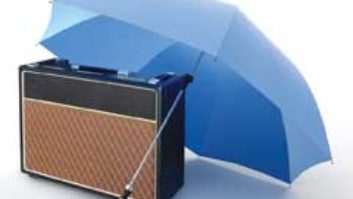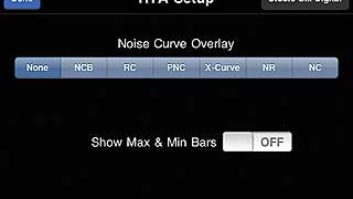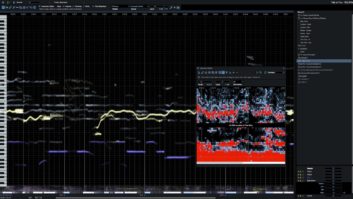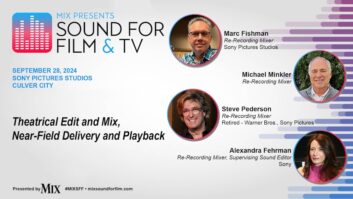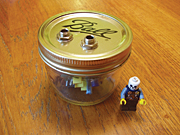
D.I.Y. is F-U-N
I was happy to see Eddie Ciletti’s “Tech’s Files: The Kit Revival” article in the December 2008 issue, and am familiar with that odd mix of curiosity, creativity and necessity that draws some of us musicians to tinker with our gear and see if we couldn’t just build it ourselves. The first truly awesome guitar tone I ever got was when I modded the little tube radio in our kitchen into a preamp for my silver-face Fender amp when I was a teenager. The article neglected to mention Build Your Own Clone (www.buildyourownclone.com), from which I assembled the “confidence booster” shown in the photo. When I mounted it in the half-pint mason jar, my 13-year-old daughter said, “I suppose you think that’s really funny.” (I actually think it’s hysterical.) Maybe it’s the mason-jar mojo, but it floored the guys in my band when we put it in front of a little Epiphone tube amp. The tone was great, but the real fun was hearing everyone ask, “You built that?”
Christopher Cassels
Christopher — We gotta agree with you about the mason-jar mojo. Finding the right enclosure for D.I.Y. kits is sometimes harder than building the circuit itself, and this one is cool. Also, thanks for the lead to the Build Your Own Clone site. There’s a lot of good stuff there. — George Petersen
The New Standards
I’m writing in response to Gavin Lurssen’s article in the December 2008 issue called “The Limits of Compression.” Though not a parent for any length of time, I can relate to his analogy and applaud his point: “The responsibility of all engineering is to learn from and maintain standards.” That’s certainly my first step in understanding my sessions. I’m still optimistic about my work and growth as an engineer, and am still fed by the original spirit that first drove me 30 years ago: real music that sounds good. These economic times shake all of our foundations in different ways, often forcing us to supplement our income in ways we thought we would never do again — added to which every kid with a computer can make something that sounds good as an MP3. Try to tell them that you can help them grow as musicians and recording artists, and see what they spend their money on instead.
In that regard, I was excited to read about “CODE” (“Mix Interview: T Bone Burnett,” October 2008) and the future of our industry’s integrity. But in talking about it with a more jaded friend of mine, he said he thought it neither mattered nor would it trickle down to the average person, the majority of whom do not pay for music and do not care what it sounds like as long as they get it in whatever form that’s free.
I also wonder about our rapid advances in another regard. Our current arsenal of vintage emulations is truly amazing. Having once owned many of these toys in hardware, having 32 LA-2s available on a mix is a new experience, let alone always having many of the dream toys I used to only be able to rent to mix certain records, and then some. When Empirical Labs — which I thought would be a permanent holdout — announced it was allowing plug-in versions of the Distressor to be created, I realized that we are running out of emulations. These classic pieces were used because of their sound, created by engineers and designers with ears. “New” plug-ins offer products that attempt to do everything in one piece, and usually do most of it poorly.
If we don’t care what it sounds like, and we don’t make new hardware to use in actual studios and develop a “sound” that’s worth emulating, our virtual world will sound like a poor emulation of what [longtime engineers] remember music sounding like, and we will be the old guys complaining about the music of today. Before I buy the new Harrison EQ plug-in, say it ain’t so — Gavin? T Bone? Anyone?
David Saia
studioSSP
West Chester, Penn.
There is some needed discussion about the loudness wars in the December 2008 issue of Mix (“Nashville Skyline,” “The Limits of Compression”), but I’m not reading solutions. I’d like to read an article with some actual tips on how to find a happy medium between a wide dynamic range and a competitive volume level on a master recording. I wish this volume war never started!
I’d like some recipes for mastering levels to be used on CD, radio and TV. I know there are no hard-and-fast rules, but some general concepts and perceived volume levels would be a good starting point to maybe begin the de-escalation of this terrible war. I’m not saying we need a timeline, but we need to begin talks now.
Chad Johnson
The Fine Print
You recently printed letters praising your new format and layout for Mix (“TalkBack,” November 2008). The opinions expressed all seem to be positive. Is it possible that you never received any contrary points of view?
The typeface for articles is too small. Of all the magazines that I receive, Mix is the only one that is difficult to read. It is also the most important to me in my career. My optometrist tells me that I do not need reading glasses.
I scanned several examples of recent magazines: two pages from Mix, then a page each from MacWorld, Consumer Reports and the Los Angeles Times. They were all scanned at exactly the same resolution. If you will look at them, one after the other, you will see that the smallest and most squint-inducing by far is Mix. I’m sure you have made a decision to save paper in difficult economic times, but I think you have gone too far.
Les Brockmann
This month’s Talkback question: How did the FCC wireless band changeover affect you? E-mail us at mixeditorial@mixonline.com.

